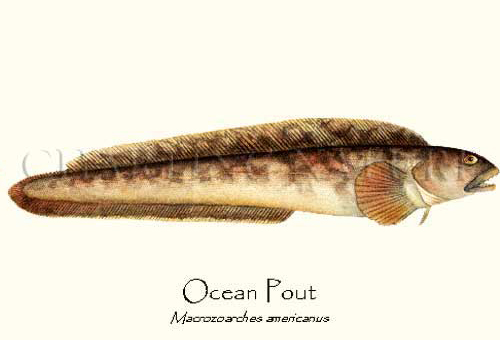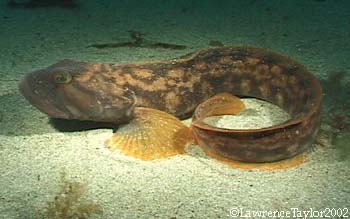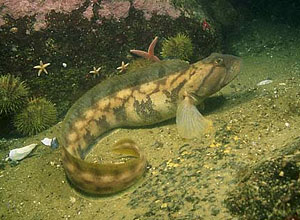
Zoarces americanus
FAMILY
Zoarcidae
TAXONOMY
Blennius americanus Bloch and Schneider, 1801, American seas.
OTHER COMMON NAMES
English: Muttonfish, yowler; French: Loquette d’Amйrique.
PHYSICAL CHARACTERISTICS
Body eel-like but rather stout in adults. Pectoral fins large and
fan-like. Pelvic fins have short splints. The dorsal and anal fins
are continuous with the caudal fin; the dorsal fin has about
15–25 tiny spines at its rear. Background color usually muddy
yellowish, tinged with brown above and becoming darker with
age. Belly usually yellowish but can be olive-green. Mottling
on the sides is brown, but the pattern is individually variable.
Teeth are green in northern populations owing to predation
on sea urchins. Scales are minute, round, and not overlapping.
DISTRIBUTION
Southern Labrador south to Virginia.
HABITAT
Adults found on the outer shelf to about 219 yd (200 m) on
sandy or muddy bottoms. Young may come into intertidal areas
among seaweed and rocks. Free-swimming hatchlings
sometimes found in estuaries of large rivers to the north.
BEHAVIOR
Very little is known of
BEHAVIOR
al traits in ocean pout, mostly
owing to the difficulty of observing them in their usual offshore
HABITAT
. Based on aquarium observations, they probably
live passive, solitary lives without territories and seem only to
congregate for spawning. Spawning consists of several copulations
over many hours. Large spawning males are aggressive to
smaller males at this time, as are females with non-spawning
females. Parental care of the eggs occurs (see below).
FEEDING ECOLOGY AND DIET
Grazer. Feeds on invertebrates on or within the sea floor,
mostly on crustaceans (amphipods, Cancer crabs, and hermit
crabs especially), sea urchins, worms, bivalves (clams and scallops),
sea snails, and brittle stars. Fish found in a few stomachs
occasionally are probably scavenged.
REPRODUCTIVE BIOLOGY
Spawning occurs in early to mid-Autumn and consists of males
approaching ripe females and rolling on their sides or even upside
down under the female. Fertilization is internal and several
copulations occur for 2–3 minutes each over many hours,
perhaps up to half a day. Egg laying occurs around 6–17 hours
after the last copulation. Large females lay a clutch of eggs in
rocky areas more numerous than smaller females. A female at
nearly 35.4 in (90 cm), near the maximum size, contained over
4,100 ripe eggs; another at 21.6 in (55 cm), and probably
spawning for the first or second time, had 1,300 eggs. The
eggs are pale yellow and measure 0.24–0.28 in (6–7 mm) in diameter.
Upon laying her egg mass the female fans and wipes
her skin over the eggs for around 30 minutes. This coats the
mass in an antibiotic mucus. Then the female wraps herself
tightly around the mass (now white in color), which helps stick
it together into an egg ball. Females remain passive while
guarding their eggs except for intermittent swimming in circles
while fanning the eggs with their pectoral fins. Incubation lasts
for three months, during which females probably do not feed
much. Fry hatch in mid-winter, and yolk sac resorption occurs
in seconds. Fry have a very short planktonic phase while working
their way inshore, where they develop over the first few
years of their lives.
CONSERVATION STATUS
Not threatened. Common in nearshore environments as young
where predation is probably low. Also common offshore even
on the fishing banks off New England and Nova Scotia.
SIGNIFICANCE TO HUMANS
A minor fishery for ocean pout began in Massachusetts in the
1930s, with fish being sold “round” in Boston markets. In
1943, as a war effort, a concerted attempt was made to sell
whole fillets, and landings reached almost 4.4 million lb (2 million
kg) in 1944. However, ocean pout are afflicted with a microsporidian
(Protozoa) parasite that produces unsightly lesions
in the flesh. Landings dropped to under 6,100 lb (2,767 kg) by
1948, and the fishery subsequently failed. Attempts to revive
the fishery in the 1970s also failed.
Photo Gallery of - Ocean pout





 Animalia Life
Animalia Life